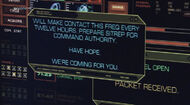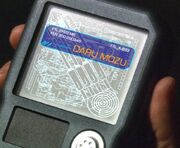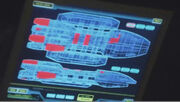| An article from the Science Series
|
|
Technologies such as computers have been mostly bane and less of a blessing to the Colonials of the Twelve Colonies, despite the obvious conveniences that technology brings. It was computer technology that led to the creation of the Cylons for household to warfare use. These intelligent machines rebelled. To counter their creation's ability to hack into computers, the Colonial defences, particularly the first battlestars, used computers but did not network them to all but eliminate Cylon infiltration.
Over 40 years after that first Cylon War and with the Cylons apparently long gone, the Colonials slowly returned to technological conveniences. When the Cylons began planning a second war against the Colonials, they chose to infiltrate the Colonial military through yet another program installed throughout fighters and battlestars that was designed to add more convenience: the Command Navigation Program. This program, thanks to Cylon agents disguised as humans who infiltrated Colonial life and sought out people who had access to Colonial computer defence technologies, contained a "backdoor" that allow the Cylon forces to damage or disable any Colonial vessel with this program. Only non-networked ships (such as most civilian ships or older battlestars herself) or those with comparatively primitive computers (such as the Viper Mark II) are all-but-immune to the new Cylon menace.

A laptop computer.
Colonial Civilian and Government Computers[]
Colonial Defence Mainframe[]
- Not much is known of this system other than its existence and the roles they played in the destruction of the Twelve Colonies. This central computer housed key Colonial Fleet logistical information, such as fleet deployment, and was the central system used to create and distribute the Command Navigation Program to all advanced ships and fighters in the Colonial Fleet. It was located within the Ministry of Defence on Caprica.
War College Simulator[]
- Simulations were performed of Cylon attacks in War College to test Colonial defence tactics. One such defence involves the use of EMP devices to fool Cylon forces into believing a nuclear device detonated where no explosion took place.
Viper Flight Simulators[]
- Normally, pilots are trained on simulators, presumably on one of the Colonies or one of the advanced battlestars, which used complex computers to immerse a trainee into the feel of Viper combat. Unfortunately, older battlestars do not have simulators aboard, so the new pilots are sometimes taught using actual Vipers.
Personal Computers[]

Colonial computer menu.

A hand-held computer.
- There are varying types of personal computers in use in the Colonies. Older computers are fairly bulky, and accept commands only through a typical keyboard and/or mouse, whereas more modern computers made after the Cylon War make heavy use of touch-screen interfaces.
- Stand-alone computers, laptop computers and tablet computers are all present in colonial society.
Data discs[]

A data disc.
Data discs are used to transfer amounts of data between separate computers. Like Colonial documents, they are hexagonal in shape, mimicking the corners cut off all pieces of colonial paper.
Portable Library Readers[]

A portable library reader.
- Portable library readers are more like a hand-held electronic dictionary or encyclopaedia. They can likely synchronize data from a personal computer.
Battlestar Computers[]
An original battlestar has several computers dedicated to many critical ship functions. An original battlestar is still a very complex spacecraft. Advanced battlestars, with their networked computers, may have more or fewer computers or distributed functionality. The networks theoretically allow the crew to control any system from any location, if one possesses the correct passwords.
[]

NAV Computer Display
Also known as the "NAV" or "NAVCON" computer, it tracks the battlestar's position and handles sublight travel and RCS translations. It is very likely that DRADIS sensor information is obtained and managed by the Navigation Computer then passed on to the Tactical Officer and the Command & Control Center in the CIC.
The DRADIS system, while having digital controls, is an analogue instrument (utilizing EM radiation), which protects it from direct external infiltration by Cylon electronic attack. The navigation computer hardware, as with practically every other computer system, is susceptible to internal compromise by Cylon viruses or logic bombs already present in the battlestar's other systems.
FTL Computer[]

FTL Systems Display
The FTL computer manages the complex calculations necessary for an FTL jump. Information for these jumps on a more advanced battlestar are probably transmitted from the Navigation Computer by the battlestar's network.
On older battlestars, however, the FTL computer receives the spatial coordinates manually from the officers in CIC. The FTL computer also manages the star fixes of the jump coordinates to compensate for inertial drift that naturally occurs over time.
Damage Control Computer[]

Damage Control display
The Damage Control computer relays information to the CIC on malfunctioning or damaged areas of the battlestar, presumably from various sensors throughout the ship. It also has access to radiation sensors in the event of nuclear attack to warn against dangerous radiation levels that could harm the crew. The DC computer's function can be compromised by a hostile force through places such as Aft Damage Control. If these locations are compromised, the computer's safeties can be overridden and various life-support controls, such as bulkheads and atmospheric controls, could be altered, venting the ship's air (and crew) into space.
Fire Control Computer[]

Fire Control Display Panel
The Fire Control computer manages a battlestar's primary offensive weapons, the central flak turret and smaller port and starboard turrets along the length of each side of the ship. It is presumed that the Fire Control computers report to crewmembers responsible for the upkeep of ammunition on the guns when to reload a particular turret. The Fire Control computer can target individual bogeys with the flak turret guns, which, in tandem with the smaller turrets, make even an old original battlestar from the first Cylon War, a formidable foe to encounter. Like the DC computer, there are control rooms on battlestars where the ship's computerized gun control can be overridden.
Mainframe Computer[]
This computer likely manages secondary functions of the ship, such as communications. The mainframe likely provides extra calculating power for other ship tasks when required, and may also serve as the ship's library for tactical information. Of all the computers on battlestars, this computer is likely very resistant by design to infiltration since it controls communication traffic (and thus is accessible to Cylon external intrusion by wireless). The mainframe likely possesses a basic gateway, but, per old battlestar's no-networks edict, it is typically unused.
The communications elements of the mainframe, while having digital controls, are analogue instruments, which make them highly resistant to external Cylon electronic attack as they do not transfer digital signals. As with other battlestar systems, the mainframe hardware remains susceptible to internal Cylon electronic attacks (viruses and logic bombs that infect and transfer from other systems).
Environmental Computer[]
The environmental computer is likely connected to the nearly one-dozen carbon dioxide air scrubbers throughout a battlestar, which remove the excess levels of the gas before it reaches toxic levels.
Avionics[]
- The computer systems found on fighters and support aircraft of a capital ship are generally described by the term avionics (AVIation electrONICS). In the world of Battlestar Galactica, aircraft terminology is intermixed with spacecraft terminology--note the use of "CAG" and use of the word "planes" to describe the Viper space fighter.
Colonial Avionics[]
The Colonial Fleet relied initially on primitive, hard-wired avionics in its early fighters, but later reverted to more "fly-by-wire" technologies, one of which sealed the doom of billions of citizens.
Vipers and Raptors[]

A view of the manual "8-ball" landing software on a Viper Mk. II.

A view of a Mk. II secondary display below the primary display, currently using DRADIS.
The avionics found on modern Vipers and Raptors are complex systems that combine fly-by-wire technology with computer systems.
In the case of Raptors, datacord is used for networking subsystems. This wiring makes Raptors more radiation-hardened and thus useful in high-radiation conditions.

Viper Mk. II cockpit avionics, resistant to Cylon infiltration.
The older and generally-obsolete Viper Mark II fighters have a more primitive avionics package, but unlike CNP-equipped Viper Mark VIIs and Raptors, these old-style Viper systems (a design similar to that used in the Cylon War) appear to combine hydraulics with a basic computer and DRADIS subsystem that is effectively immune from Cylon electronic counter-attack.
Both Vipers are equipped with a multi-functional display that can can be set to various modes, such as DRADIS, navigation, engines, system status and weapons.
The flight systems of these systems also likely include these components, which vary in availability or degrees of complexity depending on the craft's age or purpose:
- A non-directional medium-range wireless communications for ship-to-ship and ship-to-planet contact
- DRADIS hardware for enemy targeting, squadron formation flight manoeuvres, etc.
- A Colonial transponder for IFF "friend or foe" identification
- Stellar positioning system for proper sublight or FTL navigation
- Larger craft such as Raptors can manage FTL jumps and so come equipped with more advanced avionics to handle jump computations
- Instrument Landing Systems (ILS), an automatic ("hands-off") landing system guidance package
Vulnerabilities[]

Viper Mk. VII cockpit avionics, vulnerable if the CNP is installed.
In the case of modern (pre-holocaust) spacecraft, many of these systems were likely tied into (either as a software or firmware component) the tainted Command Navigation Program.
Some older commanders prohibit computerised landings, so all pilots perform manual approach and landings in non-combat situations. No information has been given in the series if Mark II Vipers are capable of auto-landings in the manner that Mark VIIs demonstrate.
Notes[]
- Colonial aesthetics often eschew right angles, instead using octagons. Many computer programs also follow this design by having windows, menus or buttons with angled corners.